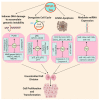Mechanisms of Oncogenesis by HTLV-1 Tax
- PMID: 32645846
- PMCID: PMC7399876
- DOI: 10.3390/pathogens9070543
Mechanisms of Oncogenesis by HTLV-1 Tax
Abstract
The human T-cell lymphotropic virus type 1 (HTLV-1) is the etiological agent of adult T-cell leukemia/lymphoma (ATLL), a neoplasm of CD4+CD25+ T cells that occurs in 2-5% of infected individuals after decades of asymptomatic latent infection. Multiple HTLV-1-encoded regulatory proteins, including Tax and HTLV-1 basic leucine zipper factor (HBZ), play key roles in viral persistence and latency. The HTLV-1 Tax oncoprotein interacts with a plethora of host cellular proteins to regulate viral gene expression and also promote the aberrant activation of signaling pathways such as NF-κB to drive clonal proliferation and survival of T cells bearing the HTLV-1 provirus. Tax undergoes various post-translational modifications such as phosphorylation and ubiquitination that regulate its function and subcellular localization. Tax shuttles in different subcellular compartments for the activation of anti-apoptotic genes and deregulates the cell cycle with the induction of DNA damage for the accumulation of genomic instability that can result in cellular immortalization and malignant transformation. However, Tax is highly immunogenic and therefore HTLV-1 has evolved numerous strategies to tightly regulate Tax expression while maintaining the pool of anti-apoptotic genes through HBZ. In this review, we summarize the key findings on the oncogenic mechanisms used by Tax that set the stage for the development of ATLL, and the strategies used by HTLV-1 to tightly regulate Tax expression for immune evasion and viral persistence.
Keywords: ATLL; HTLV-1; NF-κB; Tax; apoptosis.
Conflict of interest statement
The authors declare no conflict of interest.
Figures



References
-
- Poiesz B.J., Ruscetti F.W., Gazdar A.F., Bunn P.A., Minna J.D., Gallo R.C. Detection and isolation of type C retrovirus particles from fresh and cultured lymphocytes of a patient with cutaneous T-cell lymphoma. Proc. Natl. Acad. Sci. USA. 1980;77:7415–7419. doi: 10.1073/pnas.77.12.7415. - DOI - PMC - PubMed
-
- Wolfe N.D., Heneine W., Carr J.K., Garcia A.D., Shanmugam V., Tamoufe U., Torimiro J.N., Prosser A.T., Lebreton M., Mpoudi-Ngole E., et al. Emergence of unique primate T-lymphotropic viruses among central African bushmeat hunters. Proc. Natl. Acad. Sci. USA. 2005;102:7994–7999. doi: 10.1073/pnas.0501734102. - DOI - PMC - PubMed
Publication types
Grants and funding
LinkOut - more resources
Full Text Sources
Research Materials
Miscellaneous

